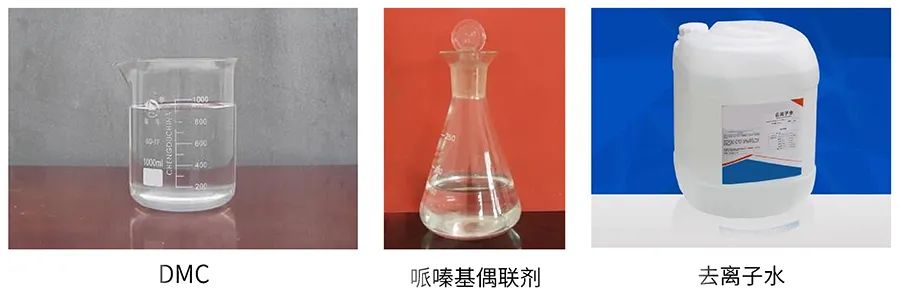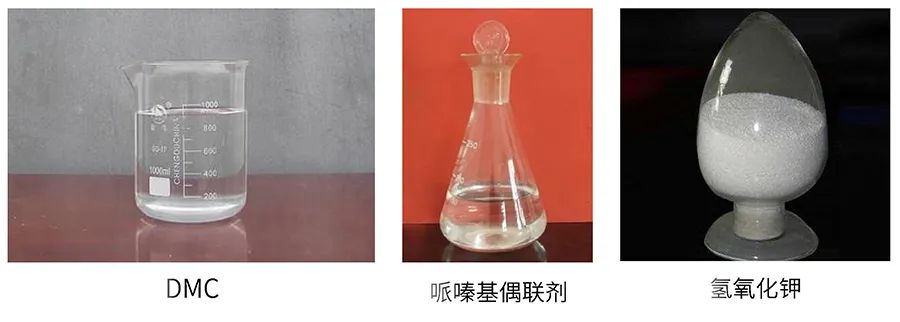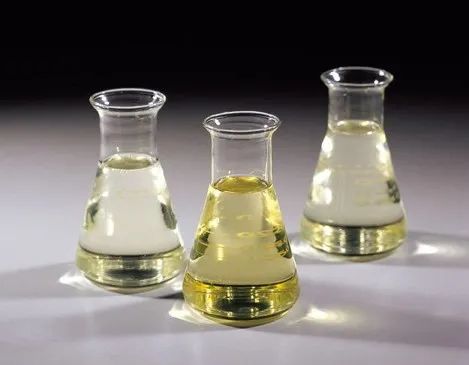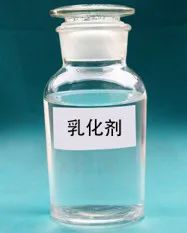Preparation of smooth amino silicone oil

Smooth crude oil generally uses linear bodies as raw materials. First, pump the linear body into the kettle, start stirring, and add the piperazine-based coupling agent. The coupling agent generally does not require hydrolysis. Raise the temperature to 70-80°C and add the catalyst. The catalyst is tetramethylammonium hydroxide and potassium hydroxide. , lithium hydroxide, depending on the viscosity, choose different catalysts, the amount added is about one ten thousandth. Continue to raise the temperature to 110-120°C, keep it warm for 1 hour, and then vacuum. The vacuum time depends on the viscosity of the oil, usually 10-60 minutes. After the viscosity of the oil reaches the requirement, it is cooled to below 80°C and discharged for later use.
Use linear bodies to make several types of silicone oil:
0.03-0.05N, viscosity between 500,000-1 million CP;
0.1-0.15N, viscosity between 50,000 and 100,000 CP;
0.4-0.45N, viscosity between 20,000 and 50,000 CP;
Usually it means adding 1kg of coupling agent per 100kg of linear body is 0.1N.

Preparation of soft amino silicone oil
Soft crude oil generally uses D4 or DMC as raw material. The production method of using D4 or DMC to make amino silicone oil is:
1. Hydrolysis of coupling agent
First put 100kg of piperazine-based coupling agent into the reaction kettle, add 20kg of deionized water, start stirring, open the drain valve of the receiver, raise the temperature, and when it reaches 80°C, turn on the cooling water of the condenser and continue When the temperature rises to 130°C, close the evacuation valve and turn on the vacuum. During the vacuuming process, the temperature of the material is raised to 150°C, cooled to below 80°C, discharged, and weighed.
Yield = weight after dehydration/input amount (usually 0.8)

2. Synthesis of amino silicone oil
Pump 200kg of DMC into the reaction kettle. When the temperature rises to 80°C, add (20g potassium hydroxide + 180g water), raise the temperature to 145~150°C, and after 1 hour of heat preservation, measure the viscosity at 2000~5000CP. There is no need to lower the temperature. Add a completely hydrolyzed piperazine-based coupling agent, such as 0.6N (12kg*yield), then add potassium hydroxide (20g potassium hydroxide + 20g water), and keep it warm at 145+150°C for 1 hours, the viscosity is above 5000. It can be cooled to below 80℃. If the viscosity of the discharged material is high, vacuum reaction can be carried out before cooling down to the required viscosity. If the viscosity is required to be small, MM or MDM head sealing agent can be added before cooling down, and then the catalyst can be added to reduce the viscosity.
Oils produced with D4 or DMC are: 0.6N with a viscosity of 5000 to 1000CP, and 0.9N with a viscosity of 1000CP.

Preparation of icy silicone oil
A. Smooth type
0.03-0.05N crude oil,
Viscosity 500,000-1,000,000 CP 40kg
0.1-0.15N crude oil,
Viscosity 50,000-100,000 CP 40kg
0.4-0.45N crude oil,
Viscosity 20,000-50,000 CP 20kg
Emulsifier T05 10kg
T07 10kg
Glacial acetic acid 0.8kg
Glycerin 100-200kg
Water 150kg
After stirring all kinds of crude oil in the formula evenly, add emulsifier, stir for 5-10 minutes, add acid water, add glycerin, and stir at high speed to disperse30-60 minutes, then slowly add the remaining water until all the water is added, adjust the pH value to 5-6, filter and package.
B, loose and soft type
Add high ammonia value silicone oil to the loose and soft type, but do not add too much, otherwise the cotton feeling will be too strong. The reference formula is as follows:
0.03-0.05N crude oil,
Viscosity 500,000-1,000,000 CP 40kg
0.1-0.15N crude oil,
Viscosity 50,000-100,000 CP 30kg
0.4-0.45N crude oil,
Viscosity 20,000-50,000 CP 20kg
Emulsifier T05 10kg
T07 15kg
Glacial acetic acid 1kg
Glycerin 100-200kg
Water 150kg
Emulsification process:
First add 10-20kg of water into the high-speed stirring kettle, add T05 and T07, stir evenly, add various amino silicone oils to the kettle, stir at high speed for 20 minutes, add glacial acetic acid, and divide the glycerin several times Add, stir at high speed for 40-60 minutes, slowly add water until all water is added, adjust pH to 6-7, stand still, filter and package.
Reference for the applicable range of amino silicone oil with different ammonia values
0.02-0.1N is suitable for use as a deepening agent
0.1-0.2N is suitable for smoothing agent
0.2-0.3N polyester nylon softener
0.3-0.4N cotton softener
0.4-0.6N cotton and wool soft finishing agent
0.6-0.9N acrylic, rayon soft finishing
Triamine piperazine 0.3-0.5N soft finishing of cotton, rayon and acrylic fiber
Piperazine 0.3-0.5N soft finishing of cotton and rayon
The effect of coupling agents on the quality of synthetic amino silicone oil

1. 602 coupling agent
602 is the most commonly used silane coupling agent. It has the advantages of good hand feel and strong versatility on various types of fabrics. However, it has the disadvantage of large yellowing and its application is greatly restricted.
2. KH550
When used to make amino silicone oil, water cannot be added to the coupling agent. It is usually used in large quantities in emulsion polymerization. It has the advantage of less yellowing and high resilience due to self-crosslinking. It is used for smooth, rebound and stiff finishing.
3. Piperazine-based coupling agent
Because the amino group in the piperazine-based coupling agent is not exposed, it has the characteristics of less yellowing and semi-hydrophilicity, and is widely used in the finishing of cotton fabrics, acrylic fibers, and rayon.
4. Triaminopiperazine
Triaminopiperazine has one more group than the piperazine-based coupling agent, so it has more fluffy properties and is widely used for fluffy finishing of cotton and rayon.
5. 560 coupling agent
560 coupling agent is a self-crosslinking coupling agent with an epoxy group. It does not turn yellow when finishing fabrics. It is mostly used in emulsion polymerization. It makes the finished fabrics dry, smooth and elastic.
Selection of emulsifier
1. TO isotridecyl alcohol series
Because the TO series has extremely strong emulsification and penetration properties, it is widely used as an emulsifier for smoothing agents, wool mercerizing softeners, etc. The disadvantage is that the cationic amino silicone oil emulsified by the TO series has strong polarity and is easy to color and stick to the roller. Use sparingly on long car finishes.
2. XL isomeric ten alcohol series
It has moderate emulsification penetration and is widely used in cotton chemical fiber finishing agents.
3. Fatty alcohol AEO series
The emulsification penetration is poor, especially the softener used for cotton fabrics can reduce the sticking phenomenon.
4. The choice of emulsifier is very important in smoothing softeners. Generally, it is more ideal to use two series in one smoothing softener.
Ice-feeling additives for ice-feeling silicone oil
Where does the ice feeling of ice-feeling silicone oil come from? It is that the silicone oil emulsion is added with non-volatile solvents with boiling points above 200°C, such as ethylene glycol monobutyl ether, with a boiling point of 230°C; white oil, also known as paraffin. Oil, white oil, mineral oil, boiling point ≥ 250°C; glycerol generally uses industrial glycerol, which is synthesized using propylene as raw material. The resulting glycerol is called synthetic glycerol, with a boiling point of 290°C. One or more non-volatile solvents are added to the silicone oil emulsion for post-finishing of the fabric. After the silicone oil emulsion adsorbed on the surface of the fabric is set at high temperature, it reacts with the hydroxyl groups on the fiber surface and combines to form a film. The adsorbed solvent remains. Remains on the fiber surface, thus reflecting the cold feeling. After the fiber is washed, this feeling is gone, so it is not washable.